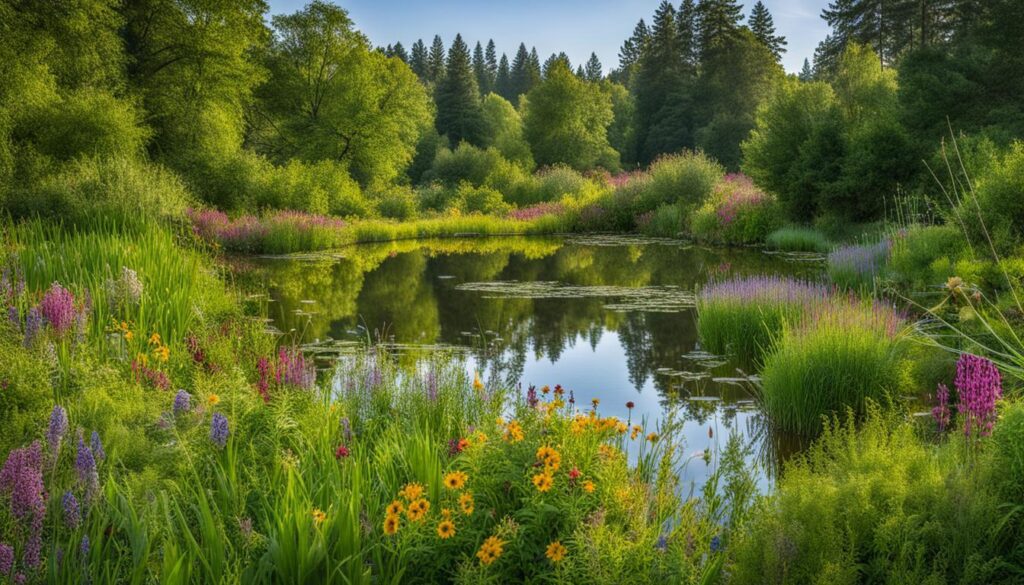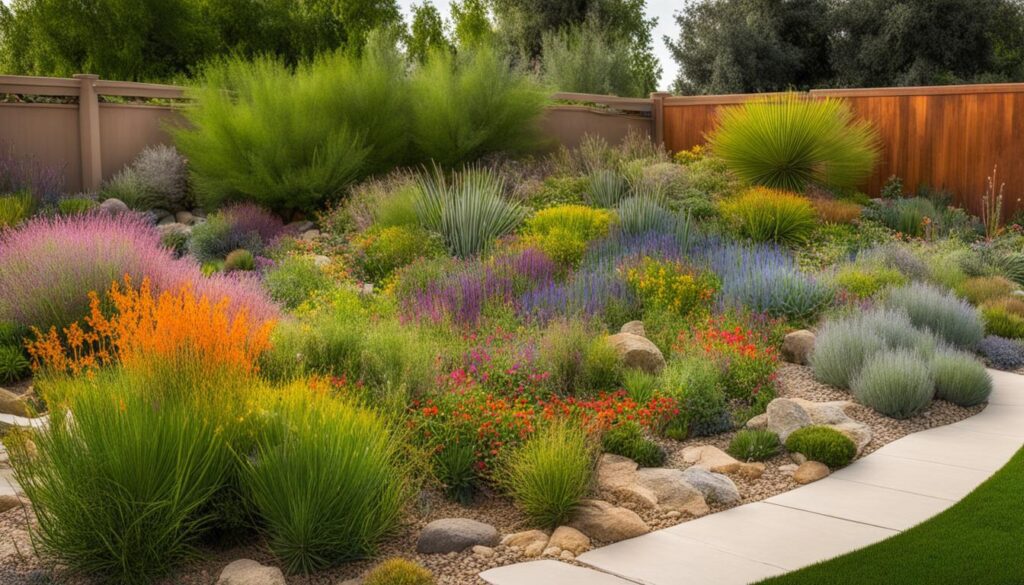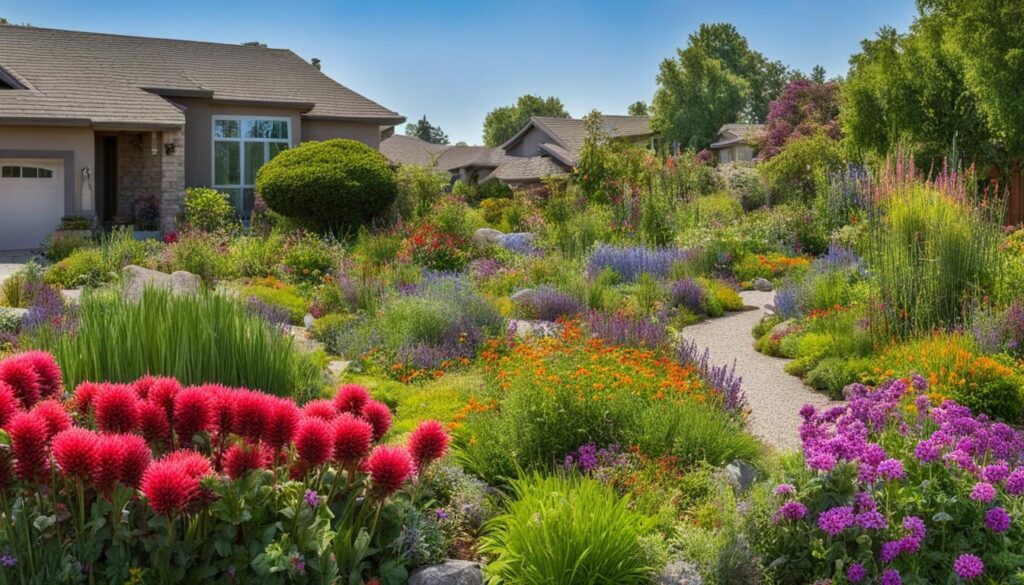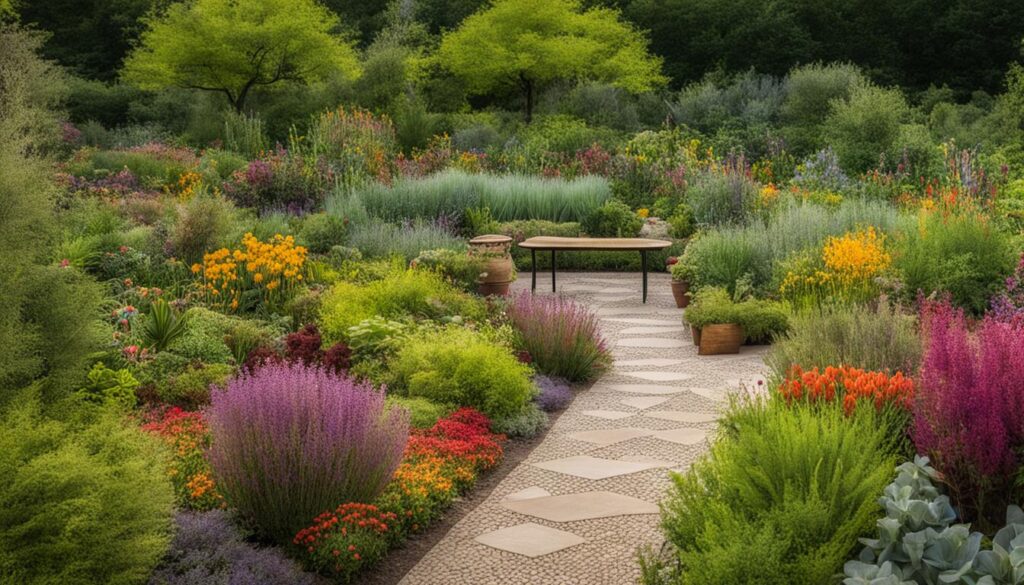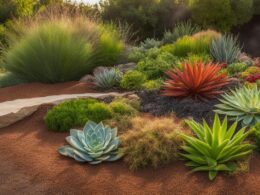Welcome to our article on xeriscaping for biodiversity and wildlife habitats. Xeriscaping is a landscaping technique that not only creates a beautiful garden but also promotes the well-being of local wildlife and contributes to biodiversity. By incorporating xeriscaping principles and using native plants, you can conserve water, reduce the need for harmful chemicals, and create a sustainable habitat for various species. Let’s explore the benefits of xeriscaping with native plants and how you can implement this environmentally-friendly practice.
Key Takeaways:
- Xeriscaping is a landscaping technique that promotes biodiversity and creates wildlife-friendly habitats.
- Native plants are well-adapted to the local climate and soil conditions, making them more drought-resistant and resilient.
- Implementing xeriscaping with native plants involves careful planning and consideration.
- Native plants have deep root systems that help prevent soil erosion and reduce water runoff.
- There are numerous resources available for further learning about xeriscaping and native plants.
The Benefits of Native Landscaping
Native landscaping offers numerous benefits for both the environment and gardeners alike. By choosing native plants, you can create a beautiful and sustainable landscape that contributes to biodiversity and promotes long-term sustainability.
The Benefits:
- Water Conservation: Native plants require less water, as they are well-adapted to the local climate and soil conditions. This reduces the need for excessive irrigation and helps conserve water resources.
- Reduced Chemical Use: Native plants have natural pest resistance and do not require fertilizers, reducing the need for harmful chemicals. This promotes a healthier and more eco-friendly garden environment.
- Wildlife Habitat: Native plants provide food and shelter for wildlife, attracting a diverse range of species and promoting biodiversity. By creating a native landscape, you can support and nurture local ecosystems.
- Low Maintenance: Native plants are well-suited to the local environment and require minimal maintenance. They are naturally adapted to the surrounding conditions and are more resilient to pests, diseases, and extreme weather events.
By incorporating native plants into your landscape, you not only create an aesthetically pleasing garden but also contribute to the preservation of natural ecosystems. Native landscaping offers a sustainable and wildlife-friendly approach that benefits both the environment and your enjoyment of your outdoor space.
“Native landscaping promotes a harmonious relationship between humans, nature, and wildlife, fostering a thriving and sustainable ecosystem in your own backyard.”
Xeriscaping and Native Plants
Xeriscaping, when combined with the use of native plants, is a powerful tool for water conservation in landscaping. Native plants are well-suited to the local climate and soil conditions, making them naturally adapted to survive with minimal water. By incorporating native plants into your xeriscaping design, you can create a beautiful and sustainable landscape that requires less irrigation and maintenance.
Native plants have evolved over time to thrive in specific regions, developing deep root systems that help them access water and nutrients efficiently. These deep roots also contribute to the prevention of soil erosion and the reduction of water runoff. By reducing water runoff, native plants play a vital role in recharging groundwater and preventing flooding.
Furthermore, native plants are essential for supporting local ecosystems and promoting biodiversity. They provide food and shelter for native wildlife, attracting birds, butterflies, and other beneficial insects to your garden. By choosing native plants for your xeriscaped garden, you can create a vibrant and ecologically balanced habitat, contributing to the preservation of local flora and fauna.
How to Implement Xeriscaping with Native Plants
Implementing xeriscaping with native plants is a sustainable gardening practice that allows you to create a beautiful and low-maintenance landscape while conserving water and supporting local wildlife. Follow these steps to successfully incorporate xeriscaping in your garden:
1. Choose Native Plants Suitable for Your Region
Start by selecting a variety of native plant species that are well-adapted to your specific site conditions. Consider the climate, soil type, and sunlight exposure in your area. Native plants are naturally resilient and require less water and maintenance than non-native species. Look for plants that are drought-tolerant, pest-resistant, and provide food and shelter for local wildlife.
2. Prepare the Soil
Proper soil preparation is essential for the success of your xeriscaped garden. Remove any existing weeds or grass and amend the soil with organic matter to improve drainage and nutrient retention. This will help the native plants establish deeper root systems, making them more drought-resistant. Avoid over-amending the soil, as native plants are adapted to the natural conditions in your area.
3. Mulch and Conserve Water
Apply a layer of mulch around your native plants to retain soil moisture, suppress weed growth, and regulate soil temperature. Organic mulches, such as wood chips or straw, are recommended as they break down over time and improve soil health. Additionally, consider using efficient irrigation methods such as drip irrigation or soaker hoses to minimize water waste and ensure that water reaches the roots of your native plants.
By implementing these strategies, you can create a sustainable and wildlife-friendly garden that conserves water and nurtures the local ecosystem. Xeriscaping with native plants not only benefits the environment but also provides you with a vibrant and thriving landscape to enjoy.
Native Plants and Environmental Conservation
When it comes to environmental conservation, native plants are a powerful tool. Their deep root systems play a crucial role in preventing soil erosion and reducing water runoff. This not only helps to recharge groundwater but also prevents flooding in vulnerable areas. Native plants act as natural filters, removing pollutants and sediment from water sources and improving water quality. By incorporating native plants into your landscape, you can contribute to the preservation of natural ecosystems and protect the environment.
Native plants are perfectly adapted to the local climate and soil conditions, making them more resilient and self-sufficient. They require less water and maintenance compared to non-native species, reducing the need for irrigation and harmful chemicals. By choosing native plants, you can create a sustainable garden that supports local wildlife and promotes biodiversity.
Benefits of Native Plants for Environmental Conservation:
- Prevent soil erosion and reduce water runoff
- Recharge groundwater and prevent flooding
- Act as natural filters, improving water quality
- Require less water and maintenance
- Promote biodiversity and support local wildlife
“Native plants are not just beautiful, they are essential for the health and preservation of our environment. By planting native species, we can make a positive impact on the conservation of our natural resources and create a more sustainable future.”
– Environmental Conservation Expert
By embracing native plants in your landscaping efforts, you are making a conscious choice to protect and preserve the environment. Whether you have a small garden or a large landscape, incorporating native plants is a simple yet impactful way to contribute to environmental conservation.
Next, we will explore the various resources available to learn more about xeriscaping and native plants, allowing you to take your journey towards environmental conservation to the next level.
Resources for Learning More About Xeriscaping and Native Plants
Are you ready to delve deeper into the world of xeriscaping and native plants? There are plenty of excellent resources available to help you expand your knowledge and skills. Whether you prefer online sources or enjoy flipping through the pages of a good book, these recommendations will guide you on your journey to creating a beautiful and sustainable landscape.
Helpful Websites
- centraltexasgardening.info: This website is a treasure trove of information on gardening, including xeriscaping tips specific to the Central Texas region. You’ll find practical advice, plant guides, and inspiration for designing your own water-wise oasis.
- xeriscape.sustainablesources.com: Explore this comprehensive resource to learn about the principles of xeriscaping and discover ideas for creating sustainable landscapes. It covers everything from plant selection to irrigation techniques, making it an invaluable tool for any aspiring xeriscaper.
- wildflower.org: If you’re passionate about native plants and their role in supporting biodiversity, this website is a must-visit. It offers a wealth of information on native plant species, gardening tips, and conservation efforts. You can also find resources for identifying and cultivating native wildflowers.
- npsot.org: The Native Plant Society of Texas website is an excellent resource for learning about native plants, their conservation, and their ecological importance. You’ll find useful guides, native plant databases, and information on events and educational programs.
- txsmartscape.com: This website specializes in promoting water-efficient landscaping practices in Texas. It provides valuable resources on xeriscaping, including plant recommendations, design ideas, and guidance on water conservation strategies.
Recommended Books
- “The Legend of the Bluebonnet” by Tomie DePaola: This beautifully illustrated children’s book shares the story of a young Native American girl who sacrifices her most cherished possession to bring life and color to her drought-stricken village. It teaches the importance of valuing and nurturing our natural environment.
- “Roots, Shoots, Buckets & Boots: Gardening Together with Children” by Sharon Lovejoy: Perfect for parents and educators, this book offers creative ideas for involving children in gardening. It emphasizes the use of native plants and shows how to create engaging outdoor spaces that foster a love for nature.
- “The Dry Gardening Handbook: Plants and Practices for a Changing Climate” by Olivier Filippi: For those living in arid regions, this book is a valuable resource. It provides practical advice on selecting, planting, and caring for drought-tolerant plants, as well as techniques for water-wise gardening.
- “Xeriscaping: Planning and Planting Low-Water Gardens” by Mark Rumary: This comprehensive guide covers all aspects of xeriscaping, from designing your landscape to choosing the right plants and implementing efficient irrigation methods. It includes helpful diagrams, plant profiles, and step-by-step instructions.
With these resources at your fingertips, you’ll have the knowledge and inspiration to embark on your xeriscaping journey. Explore the websites, immerse yourself in the books, and let your creativity bloom as you create a sustainable and beautiful garden that supports native plants and wildlife habitats.
How Can Xeriscaping Support Biodiversity and Wildlife Habitats?
Xeriscaping, with its focus on water efficiency and native plantings, provides significant conservation benefits of xeriscapes. By reducing the need for irrigation and pesticides, xeriscapes support biodiversity and create natural habitats for wildlife. This landscaping approach promotes a healthy ecosystem and helps preserve local flora and fauna.
Conclusion
Xeriscaping with native plants is an effective way to enhance the biodiversity of your garden and create wildlife-friendly habitats. By incorporating water-saving techniques and selecting native plant species, you can reduce water consumption, eliminate the need for harmful chemicals, and contribute to the conservation of local ecosystems.
Xeriscaping promotes sustainability and allows nature to thrive in developed landscapes. The use of native plants in xeriscaping not only beautifies your garden but also provides a natural habitat for a variety of wildlife, including birds, butterflies, and beneficial insects.
Embracing xeriscaping practices not only benefits the environment but also creates a beautiful and resilient garden that you can enjoy for years to come. By supporting biodiversity and wildlife habitats through xeriscaping, you play a vital role in preserving the natural beauty of our ecosystem and ensuring a sustainable future for generations to come.






